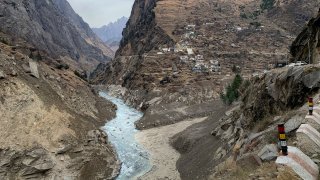
- Ice sheets across the Himalayas have shrunk 10 times faster in the past four decades than during the previous seven centuries.
- The rapid ice melt threatens agriculture and water supply for millions of people in South Asia, according to research published Monday in the journal Scientific Reports.
- There is scientific consensus that human-caused climate change has resulted in accelerated ice melt from glaciers and higher ocean temperatures across the world.
Glaciers in the Himalayas are melting at an "exceptional" rate, according to new research that shows the massive ice sheets in the region have shrunk 10 times faster in the past four decades than during the previous seven centuries.
The research, published Monday in the journal Scientific Reports, found that mass ice loss from nearly 15,000 ice sheets in the Himalayas is especially rapid compared with other parts of the world.
The Himalayan mountains are also referred to as the third pole because they hold the world's third-largest amount of glacier ice, following Antarctica and the Arctic. The ice melt threatens agriculture and water supply for millions of people in South Asia, the report said, and will contribute to rising sea levels that threaten coastal communities across the world.
Get Boston local news, weather forecasts, lifestyle and entertainment stories to your inbox. Sign up for NBC Boston’s newsletters.
Researchers found that the Himalayan glaciers have lost about 40% of their area in the last several hundred years, or an estimated 390 to 586 cubic kilometers of ice — enough to raise global sea levels 0.92 to 1.38 millimeters.
There is scientific consensus that human-caused climate change has resulted in accelerated ice melt from glaciers and polar ice sheets, as well as higher ocean temperatures across the globe.
Money Report
"Undoubtedly the primary driver is a rapidly changing climate, and the Himalayan glaciers don't seem to be able to adjust fast enough to keep up with the climate changes," said Jonathan Carrivick, a University of Leeds glaciologist and a co-author of the study.
Shifts in the South Asian monsoon might also have played a role in the ice loss in the Himalayas, researchers said.
Global sea levels are forecast to rise between 2 and 6 feet by 2100, according to NASA satellite data, and such projections underestimate the impact of climate change on sea level rise.
Scientists have warned that a dangerous amount of sea level rise will occur if global warming reaches roughly 3 degrees Celsius, or 5.4 degrees Fahrenheit, above preindustrial levels. The Earth has already surpassed 1 degree Celsius of warming.






